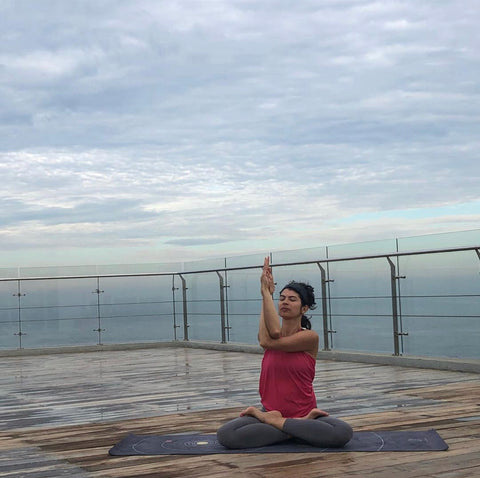Harmony Through Yoga

Yoga is as much about the physical asana practice as it is about stimulating the subtle pranic body. We might arrive at our mats to build strength and enhance flexibility, but the real transformation occurs deep within as we develop and improve our relationship to breath. Through breath, we connect to the prana—the vital life force and energy—within and all around us.
According to Indian philosophy and medicine, prana is the vital principle that sustains and permeates all life forms. Prana translates from Sanskrit as breath, energy, or vitality. Ayama translates from Sanskrit as expansion. The word pranayama is the action of expanding and controlling the breath to stimulate energy. We practice pranayamas in yoga to excite or calm the nervous system, depending on the desired outcome and how we feel. Prana helps regulate much of our physical functions, including circulation, respiration, digestion, and elimination. How we breathe is fundamentally linked to how we interact and function in the world.
The human body receives and transmits energy through the air we breathe, the food we eat, and the people and environments we surround ourselves. All the ways we directly or indirectly interact with the world affect our pranic energy. Prana travels through the body through nadis, energy channels that deliver prana to the cells. We have over 72,000 nadis in the body, but the primary seven and the ones yogis focus on, are the chakras located along the spinal column.
“Chakra translates as ‘wheel’ from Sanskrit; it’s an intersection of energy lines inside the body. It’s considered a wheel because the energy lines when they intersect create a vortex of energy.” Says Clara Roberts-Oss, a 500-hour EYRT in Vancouver, BC. Clara created the Chakra Series Playlist, where each of the seven chakras and their themes is featured in yoga, meditation, and mantra classes.
“Why do we focus on the chakras as yogis? At the base of our pelvis sits our creative force known as Shakti or Kundalini. This is this dormant creative force that lives inside of the pelvis. As yogis, we want to ignite or awaken that energy to rise from the pelvis to our third eye center where our consciousness lives. When the Kundalini energy rises, it’s said that we are awakened or that we receive enlightenment.” says Clara.
The spine is the body’s central energy channel; it’s the first thing formed in the womb and the roadmap for the nervous system that sends information to the brain. The chakras correlate with the endocrine system and the various organs and body parts where each resides, and are responsible for distributing and balancing energy.
“When the chakras are all open, the energy flows freely and we are awakened. The asana and pranayama help to move the stagnant energy that day-to-day life can create in the body. Yoga is a way to clear the stagnant energy; by observing each chakra’s themes and blockages, we create a practice to clear and move the stagnant energy—this is why we focus on the chakras.”
Maintaining spinal flexibility, strength, and mobility is essential to our overall health. The spine’s mobility affects how prana flows and how it’s distributed to the body’s various systems. The spine is one of the first places on the body that experiences stress when we over-exercise or don’t move enough throughout the day. To enhance overall mobility and distribute the prana throughout your body, try Free Your Spine with Clara. This class is suitable for all levels and features postures to strengthen the back body and open the front of the chest.
Poses from Free Your Spine
Full video available online - new members receive 7-days free!
Pose 1.

Parivrtta Utthita Ashwa Sanchalanasana (twisted low lunge variation)
Twists enhance spinal mobility and may help relieve lower back pain. Twists promote good digestion and massage the internal organs.
Pose 2.

Ashta Chandrasana - (cresent high lunge)
Lunges strengthen the legs and tone the belly. Crescent lunge provides more space in the pelvis and low back while opening the chest and shoulders.
Pose - 3

Utthita Trikonasana (triangle)
Triangle pose engages and strengthens the spine with the help of the abdominal muscles and the obliques. Lengthening of the hamstrings, glutes, and side waist provides space to breathe deep into the body.
Pose 4.

Virabhadrasana II (warrior 2 variation)
Tones the legs and abdominals while stretching the hips, groins, and shoulders. Moving flow variation with arms connects you to a deeper breath to expand the lungs.
Pose 5.

Ustrasana (camel pose)
Opens the chest, pelvis, and hip flexors. Strengthens the shoulders and erectors- muscles along the spine.
Pose 6.

Chaturanga (modified or full pushups)
Strengthens the abdominal muscles, upper back, and arms.
Pose 7.

Utthan Pristhasana (lizard)
Stretches hip flexors, groins, hamstrings, quadriceps, and chest.
Pose 8.

Ardha Hanumanasana (half splits)
Stretches the low back, hamstrings, thighs, and groins. It also strengthens the hamstrings by anchoring the front heel.
Pose 9.

Setu Bhandasana (bridge)
Stretches the spine, chest, hips, and quadriceps. Strengthens the spine, glutes, and hamstrings.
Pose 10.

Supta Matsyendrasana (reclined spinal twist variation)
Lengthens and strengthens the spine to enhance mobility. Stretches hips, chest, shoulders, upper back, and quadriceps.
Be sure to check out Clara's free 30 Day Virtual Yoga Challenge starting October 1st!
At the end of the challenge, one of our yoga mats (as well as other great prizes) will be raffled out to those who completed the journey.





Leave a comment